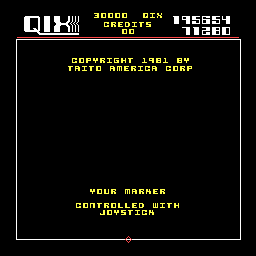Qix (set 2, smaller roms)
Game Information
| manufacturer | Taito America Corporation |
| year | 1981 |
| clone of | qix |
| other clones | qix2 qixa qixb qixo |
| genre | Puzzle |
| downloads | 51 |
Screenshots










Download Details
| split set | qixa.zip 21.12k |
| parent set | qix.zip 22.80k ↗ |
| standalone set | qixa.7z 16.81k |
Driver Details
| source | taito/qix.cpp |
| status | good |
| emulation | good |
| savestate | supported |
Screen Details
| display | screen |
| type | raster |
| orientation | horizontal |
| width | 256px |
| height | 256px |
| refresh | 55.84mhz |
Input Details
| player | 1 |
| type | joy |
| buttons | 2 |
| directions | 4 |
| player | 2 |
| type | joy |
| buttons | 2 |
| directions | 4 |
Chipset Details
| name | Motorola MC6809E |
| clock | 1.19mhz |
| name | Motorola MC6809E |
| clock | 1.19mhz |
| name | Motorola MC6802 |
| clock | 3.52mhz |
| name | Speaker |
| clock | N/A |
| name | Discrete Sound |
| clock | N/A |
ROM Details
| name | size | crc |
|---|---|---|
| u12_ | 2.00k | 5adc046d |
| u13_ | 2.00k | e63283c6 |
| u14_ | 2.00k | a2fd4c28 |
| u15_ | 2.00k | 0e5e17d6 |
| u16_ | 2.00k | 6acfa3b8 |
| u17_ | 2.00k | bc091f21 |
| u18_ | 2.00k | 610b19ce |
| u19_ | 2.00k | 11f957f4 |
| u3_ | 2.00k | 79cf997c |
| u4_ | 2.00k | e5ee74cd |
| u5_ | 2.00k | 4e939d87 |
| u6_ | 2.00k | b42ca7d8 |
| u7_ | 2.00k | d6733019 |
| u8_ | 2.00k | 8cab8fb2 |
| u9_ | 2.00k | 98fbac76 |
| u10_ | 2.00k | b40f084a |
| qq27.u27 | 2.00k | f3782bd0 |